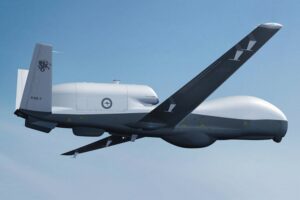DJI has entered the portable power station arena with two incredibly compelling options that are good enough to already make our guide to the best portable power stations for drone pilots. The company known for making drones in April 2024 dropped two products that are similar to each other — but that have appeal for not just drone pilots but a far broader population. Those are the DJI Power 1000 and DJI Power 500. But between the DJI Power 1000 vs Power 500, which is better for you?
In short, the DJI Power 1000 is about twice as powerful as the DJI Power 500. It’s also twice the cost. For some users, that doubling of power is critical. But for others, you might end up paying twice as much for power storage that you might ever tap into.
If money is absolutely no object, then sure, you might want the DJI Power 1000. But even that’s not always the case. Given its higher-power storage, it’s also about 12 pounds heavier. It comes in at 28.6 pounds versus just 16.06 pounds for the DJI Power 500. Certainly pilots might prefer the DJI Power 500. This guide will help you compare these new DJI stations and decide which best suits your aerial adventures.
- Purchase the DJI Power 1000 now from B&H Photo.
- Purchase the DJI Power 1000 now from Amazon.
- Purchase the DJI Power 500 now from Amazon.
The ultimate guide to DJI’s portable power stations
So what, exactly are portable power stations for? Consider them the future that’s progressed beyond generators or car chargers. Car chargers just aren’t that powerful, meaning you won’t be able to charge power-sucking products. Or if you can, it’ll be a slow process.
On the other hand, generators can be powerful. But they’re generally massive, they emit gross fumes, and they can be noisy.
Consider portable power stations like the DJI Power 1000 or DJI Power 500 to offer the best of both worlds. Even the larger of the two, the Power 1000, weighs less than 30 pounds. They recharge devices within roughly an hour. And, they’re super quiet. To prove it, the DJI Power 1000 generates just 23 dB, for example. That’s quieter than most household refrigerators.
Power stations like these certainly benefit drone pilots who need to recharge out in the field, but they’re also super useful to campers, who want to keep phones and lights recharged without the blaring noise of a generator disrupting their peace out in nature. They can also have practical function at home — serving as backup power in the case of a power outage.
So with that, here’s a guide to some of the best portable power station options from DJI:
DJI Power 1000 vs Power 500, side-by-side
| Feature | DJI Power 1000 | DJI Power 500 |
|---|---|---|
| Battery capacity | 1024 Wh | 512 Wh |
| Maximum power outputs | 2200W | 1000W |
| Fast recharge mode | 1200W | 540W |
| Standard recharge mode | 600W | 270W |
| Weight (lbs) | 28.6 | 16.06 |
| Price (USD) | $999 | $499 |
| Ideal For | Extended trips, multiple batteries | Shorter trips, backpacking |
| Standout Features | High Capacity, Fast Charging | Portable, fast charging, lightweight |
| Ports | Two 140W USB-C ports, AC port, Car port | Two 100W USB-C ports, AC port, Car port |
And let’s say you’re curious about number of times each portable power charger can recharge specific items. Here’s a table comparing recharge times on common products. Of course, if you might recharge, say, a mobile phone twice, a laptop once and a drone 3 times, you’d need to consider some combination of these charging figures:
Number of charges that common tech products can be recharged, per power station
| Feature | DJI Power 1000 | DJI Power 500 |
|---|---|---|
| Mobile phone | 57 times | 28 times |
| Laptop | 9 times | 4 times |
| Drone | 12 times | 6 times |
| Car refrigerator | 19 hours | 9.7 hours |
Now what about recharging the DJI Power stations themselves? Both devices can recharge fully within 70 minutes. If you don’t have that much time, you can at least get to an 80% charge within 50 minutes.
Who the DJI Power 1000 is best for
A true powerhouse, the Power 1000 boasts a massive 1000Wh capacity. This translates to multiple drone battery recharges, making it ideal for extended trips or supporting multiple drones on a professional shoot. It’s also expected to offer fast-charging capabilities, getting you back in the air quickly.
The drawback? It’s fairly heavy at more than 28 pounds. You don’t want to lug this around when you’re out hiking. Given that, this isn’t ideal for backpacking or situations where portability is a major concern.
Who the DJI Power 500 is best for
With a 500Wh capacity, the Power 500 is more compact and portable than its bigger brother. While not quite a powerhouse, it still offers enough juice for several drone battery charges, making it perfect for shorter outings or weekend adventures. It prioritizes fast charging as well.
At just 16 pounds, I’m not calling it light. But, it’s among the lightest portable power stations you’ll find. Consider it a great choice for drone pilots who prioritize easy carrying and want a station that fits comfortably in a backpack.
Types of supported ports
Using a standard power socket, the Power 1000 supports both 1200W Fast Recharge Mode and 600W Standard Recharge Mode. Meanwhile, the Power 500 supports both 540W Fast Recharge Mode and 270W Standard Recharge Mode.
It’s a similar story with USB-C, where the Power 500 is less powerful versus the Power 1000. Though both have two USB-C output ports, the Power 1000 is 140W with a total power output of up to 280W. The Power 500 is just 100W with a total input power of 200W.
What about solar power?
Here’s where the two are practically the same. Both products can connect to solar panels through either the DJI Power Solar Panel Adapter Module (MPPT) or the DJI Power Car Power Outlet to SDC Power Cable.
DJI Power 1000 vs Power 500: how to decide
With their impressive capacities and focus on fast charging, these stations are sure to be game-changers for drone pilots. So which should you choose? The ideal DJI Power Station for you depends on your drone and overall needs. Here’s a quick breakdown to help you decide:
- Choose the DJI Power 1000 if: You need maximum capacity for extended trips, multiple drone batteries, or professional shoots. Fast charging and the ability to power multiple devices are also priorities. Portability might be a secondary concern.
- Choose the DJI Power 500 if: You prioritize portability and a lighter weight for backpacking or frequent travel. The Power 500 still offers enough power for several drone charges and multiple device charging, making it perfect for shorter adventures. Fast charging is another benefit.
No matter which DJI Power Station you choose, you’ll be well on your way to keeping your drone, and your entire exploration kit (including laptops, lights and phones), powered for unforgettable adventures.
- Purchase the DJI Power 1000 now from B&H Photo.
- Purchase the DJI Power 1000 now from Amazon.
- Purchase the DJI Power 500 now from Amazon.
The post DJI Power 1000 vs Power 500: which is better for the price difference? appeared first on The Drone Girl.







